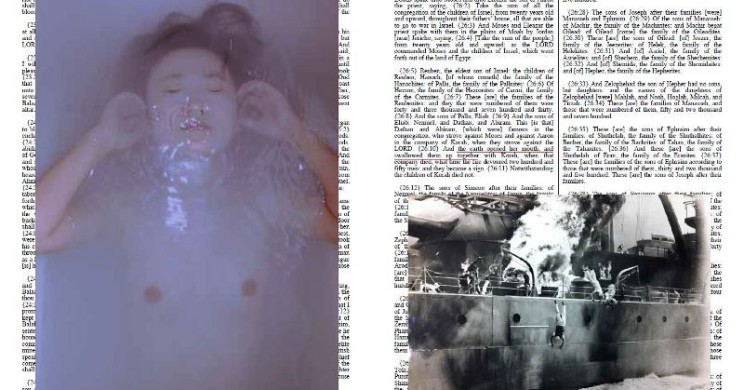The bible has been a pillar of society since its writing centuries ago. At the same time, it is a fractured and controversial document wrought not only by the wars fought in its name, but also by conflicts over the document itself, how it should be read, translated, and distributed. There are countless versions, each touted as the authoritative word of god. To this fray, Adam Broomberg and Oliver Chanarin have added Holy Bible, their own thought-provoking edition to highlight the violence of god in the bible using images from the Archive of Modern Conflict.
Earlier this year Broomberg and Chanarin won the 2013 Deutsche Börse photography prize for their work War Primer 2, a belated sequel to Bertolt Brecht’s War Primer. The pair’s Holy Bible is also based on Brecht’s work, this time his bible, which was filled with photographs of catastrophes. From the outside, Broomberg and Chanarin’s Holy Bible appears similar to any King James Version bible, with the exception of an author attribution on the spine, but the inside is filled with 512 photographs imposed over the pages’ text. Readers are free to relate the selected images to passages of underlined text and make their own connections. The images from the Archive of Modern Conflict are varied, some looking official, many more personal: images of atomic explosions, portraits of friends holding guns, a body crushed from a long fall, a smiling girl with a Nazi-era Jewish star on her dress.
Since its inception, the photograph has been a conveyor of violence, from Bayard’s Portrait of the Photographer as a Drowned Man, to Fenton’s The Valley of the Shadow of Death, to the war journalism of today. Now that everyone has a camera, everyone is a witness, each with their own politics and perspectives. These are the sources for Holy Bible, the overwhelming volume of images contained mirroring the overwhelming volume of images produced. The history depicted by the photos is also the history of how photos of conflict have evolved. But even with the proliferation of photography as a hobby, images of conflict are controlled by the news agencies who own the images that illustrate world events in our minds. They are a currency challenged by the unofficial documentation captured in Holy Bible. Or does their being housed in a sacred text, sourced from an archive, give the depicted images an aura of authority? In its depicting images counter to the officially sanctioned representations, the text calls the trustworthiness of the images into question, challenging the notion of photography as documentation, as well as how it depicts and shapes history.
Included in the work as an epilogue is an essay by Adi Ophir entitled “Divine Violence” from his Two Essays on God and Disaster. The central tenant of the essay is that god in the bible shows his might through catastrophe. When man was few and easy to handle, god’s hand was light, but as man became more numerous, “his reaction to their wickedness turned violent.” This is seen in the tales of Noah, Babel, Sodom and Gomorrah, the ten plagues and the drowning of the pharaoh’s army. Some like Lot and Abraham were given warning, the violence a lesson to those in the story. Other times there is no warning, the story of violence is used as an educational drama for the reader. Today, one prays when the victim of unexpected events. Ophir argues that for a god who benefits from disaster, this is a way of being recognized and connected with, a way for god to reveal himself. The same is true for secular institutions that try to replace god’s functions. The bible becomes a metaphor for the modern state which reveals itself through destruction.
Broomberg and Chanarin’s use of the bible, Ophir’s essay, and the images of the Archive of Modern Conflict in the form of a Brecht-ian collage brings forward issues of authorship; what it means to be an author and what it means to appropriate. The two have been working together for over twenty years, dealing with the politics of images and how these images are made, distributed and consumed, all of which is unpacked in their update to Brecht’s bible. Both Holy Bible and Brecht’s bible center around catastrophe. Both demonstrate how images in the news need to be decoded and translated. But though images are encoded with politics and framed through perspective, events need to be witnessed and documented. Holy Bible presents a vast number of conflicts, and is long on concepts and the problemetizing of packaging. It may be short on answers, but this open-endedness only serves to make it more provocative.
By Kempton Mooney

























One Response to Photographic Testament: Revamping the Holy Bible